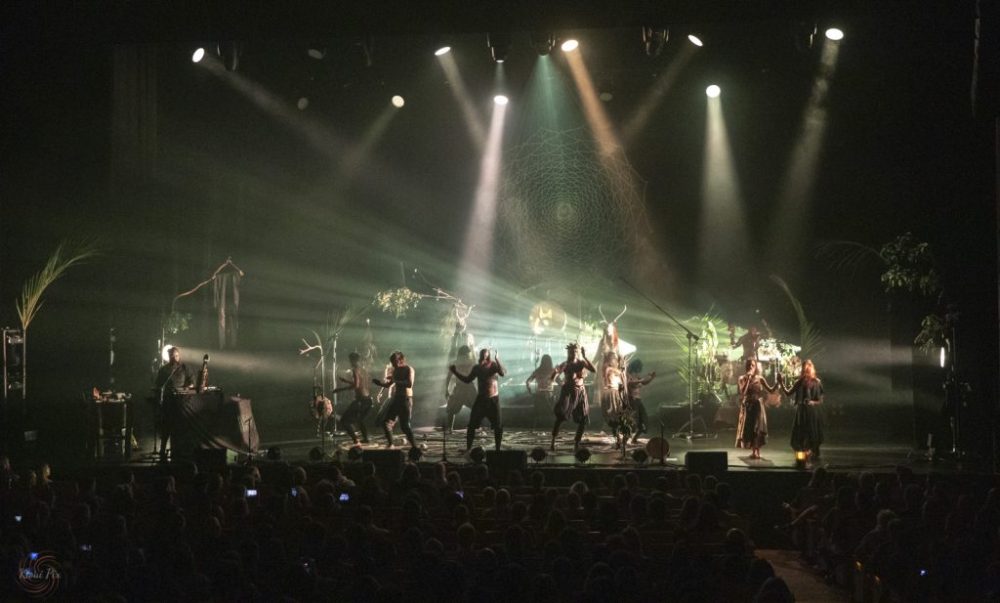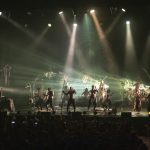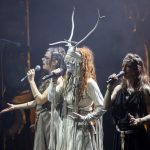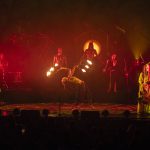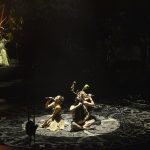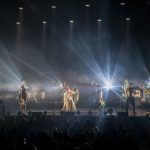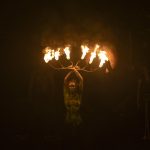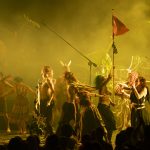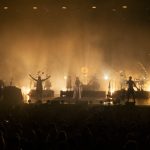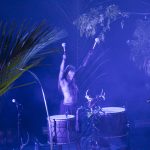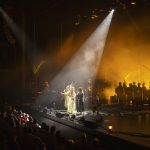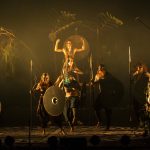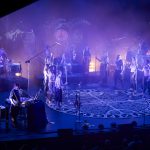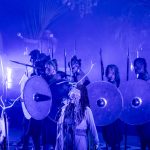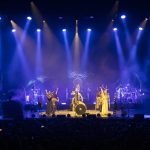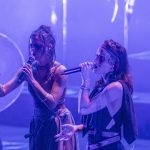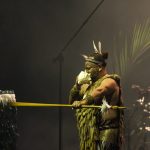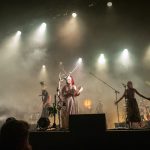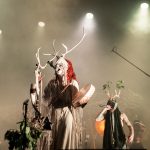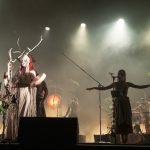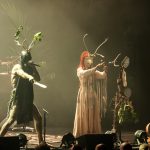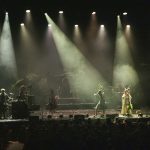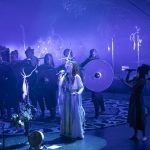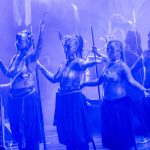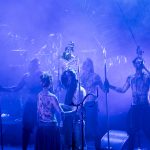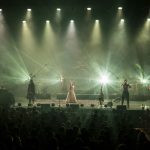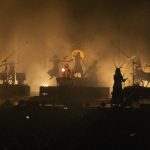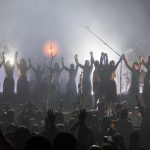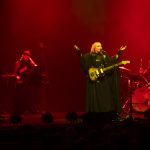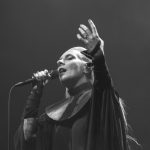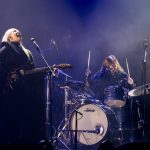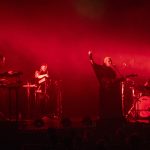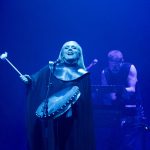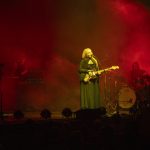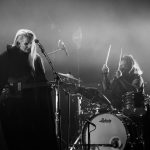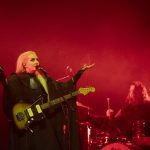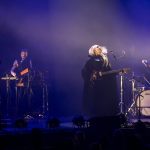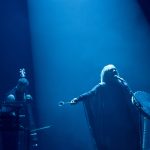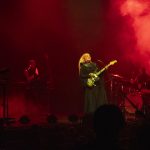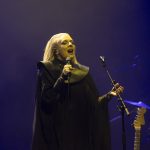Heilung & Eivør – Kiri te Kanawa Theatre: November 18, 2024 (13th Floor Concert Review)
On November 18, 2024, the Kiri te Kanawa Theatre in Tāmaki Makaurau hosted a third powerful evening filled with rich, resonant sounds as Heilung and Eivør took the stage. As the audience filed in, anticipation hung in the air, a palpable reminder of the historical and cultural tapestries that the evening would weave through music. Here are Simon Coffey’s thoughts and Ivan Karczewski’s photos.
Heilung represents a reaction, a response, to the frictional relationship between past and present, a means to heal, Heilung means healing. Formed in 2014 by Kai Uwe Faust and Christopher Juul, with Maria Franz 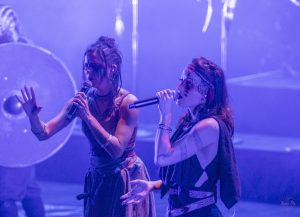 joining in 2015, onstage the three are joined by a melee of comrades, from Norway to Germany, musicians and thespians (of sort) creating an enveloping narrative (in their own words) of the “amplified history from early medieval northern Europe”
joining in 2015, onstage the three are joined by a melee of comrades, from Norway to Germany, musicians and thespians (of sort) creating an enveloping narrative (in their own words) of the “amplified history from early medieval northern Europe”
History… artistic mediums as responses to cultural imperialism aren’t a new phenomenon, from the rise of krautrock in the 1960s, artists the likes of Neu and CAN (and others) were responding to the post-war crass Americanisation of (West) German society, while in the 1980’s the rise of UK Neo-Folk, a strain of post-punk, saw flirtations with neo-paganism and pre-christian occultism by groups such as Death In June and Current 93.
Sadly, some neo-folk artists failed to be inclusive, especially with the emergence of neo-conservativism, in the mainstream of the1980s, and travelled the diminutive path of racism and separatism. Heilung are a counter to that blight, inclusiveness is a beacon within their tenet of creativity, in 2020 they made it publicly clear to the socially-inept, that divisiveness, was not welcome when it arose in the audience at one of their shows.
Eivør
Faroe Island born, but Iceland-based for most of her career, singer-songwriter Eivør Pálsdóttir is a prolific begetter of music since first starting in Faroe indie band Clickhaze in 1999 and releasing her first (solo) album in 2000.
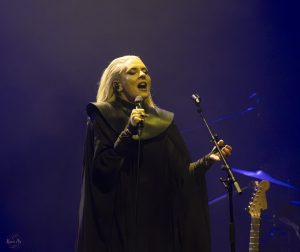 Through her score and 5 years as a creator, Eivør has traveled-many genres, from indie pop, folk, electronica and classical. Her latest album, Enn flows and ebbs between atmospheric rock, abrasive metal ballads, and neo-folkish vocal melodies. It’s an album that perhaps references unrequited romance.
Through her score and 5 years as a creator, Eivør has traveled-many genres, from indie pop, folk, electronica and classical. Her latest album, Enn flows and ebbs between atmospheric rock, abrasive metal ballads, and neo-folkish vocal melodies. It’s an album that perhaps references unrequited romance.
Faroese singer-guitarist Eivør is joined onstage by a drummer, and two keyboard/synthists, though a spotlight is overtly upon her for large parts of the 40-minute set (as she sings exclusively in Faroe). Mirroring the evolving pathways that Eivør’s music has travelled, In a concoction of electronica, drums and operatic vocals, the set of songs weaves in and out from neo-operatic heavy metal assaults, to a TV series composition (Viking) and across eclectic complex gothic rhythms.
Her last two songs are from her latest album Enn, and sit very much in the operatic rock category, they leave the audience ecstatic, her demeanour is inviting and inclusive and she references Kiri te Kanawa and her enjoyment at being in Aotearoa.
But, backtracking a little, Eivør’s vocal range is the star of the performance, she delivers a seemingly boundless range that soars in the huge venue. Her use of a hand drum comfortably juxtaposes her delivery of distorted guitar, bringing corporeality to a performance that feels ethereal.
While my compadre is nestled by the ethereal aspects of the show tonight, keyboards and synths specifically (vocals are given) I am, being an old punk rocker, much more taken by the pounding, complex rhythms coming from the drummer, Eivør”s use of the hand-drums and when the rear synthist swaps to electric stand up bass. It creates a much more unembellished nkorero. I would be intrigued to see and hear Eivør perform with just a bassist, drummer, and her wicked vocals (not forgetting guitar and hand drum)
Heilung
Inclusiveness is a fundamental ethos of Heilung, and before the music could begin. On a stage adorned in flora and darkened lighting. In birdsong. We were welcomed to the show by Māori Pūtātara (shell trumpet) and porotiti (twirling disc) followed by a haka, all of which were enthusiastically received and embraced by the audience.
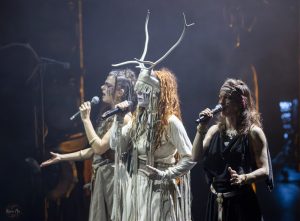 Heilung were (perhaps) recognising they were guests in Aotearoa, showing respect. This was followed by a lengthy, but spellbinding Smudging ceremony, a cleansing ritual of instruments and using incense and a leaf fan, meticulously applied possibly by a shaman-like figure. And then, with all holding hands, band and guests in a circle. On a floor rug with runes (symbolic inscriptions from Germanic peoples of the Iron Age and Viking Age) running around the edge, in unison calling a ritual-incantation or similar announcing that they/we are all brothers, a hat tip to Heilung’s philosophy, was the only time english was decisively used on the po.
Heilung were (perhaps) recognising they were guests in Aotearoa, showing respect. This was followed by a lengthy, but spellbinding Smudging ceremony, a cleansing ritual of instruments and using incense and a leaf fan, meticulously applied possibly by a shaman-like figure. And then, with all holding hands, band and guests in a circle. On a floor rug with runes (symbolic inscriptions from Germanic peoples of the Iron Age and Viking Age) running around the edge, in unison calling a ritual-incantation or similar announcing that they/we are all brothers, a hat tip to Heilung’s philosophy, was the only time english was decisively used on the po.
The ‘began’ was a descent into rhythm and voice, lights and theatrics. With toru drum and a percussion/subtle electronica stations manned throughout the night, the beat, the beats dominated the aural, though when singers joined, voice either rose above the bass rhythms to take the lead or filled the gaps between strikes.
Singers, rua lead, Faust and Franz, both adorned with deer antlers, were the mainstay, Juul joined from his percussion battlement, and many others in the 15/16 person cast interjected and enjoined throughout the night. As the post-metal, pre-folk narratives bombarded the enthralled and erstwhile audience, emotions and volume rode high and low. Meanwhile, the theatrics, the parallel narratives of movement by actors, took the gazers beyond just a concert experience, but into the realm of theatre, at times it felt Shakespearean, dark Macbeth.
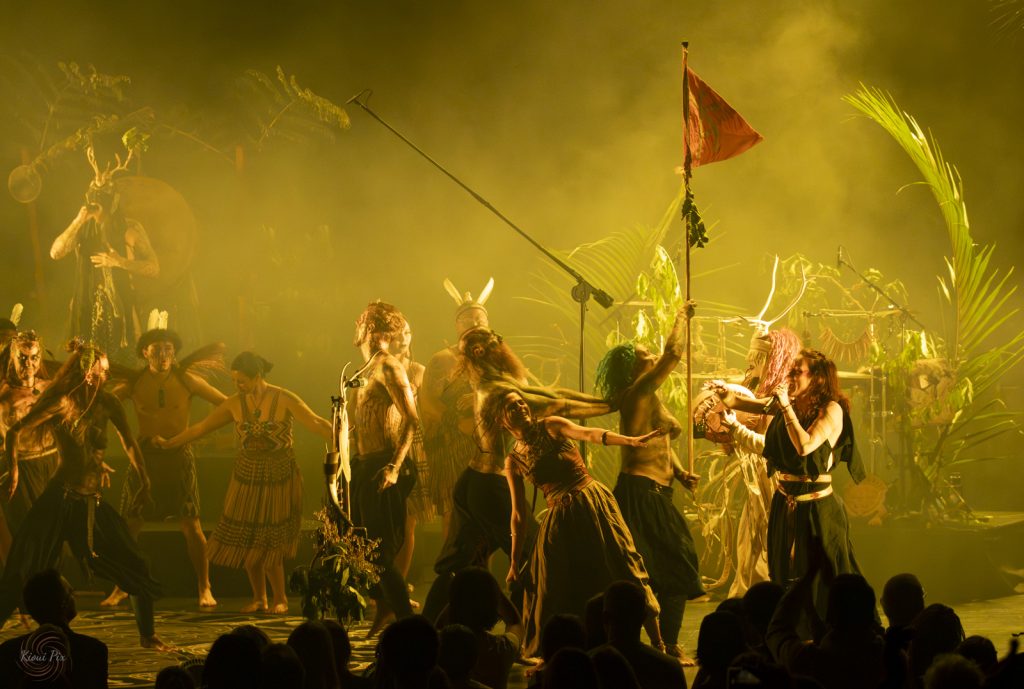
Endearing was the balance on show, not just between visual and aural, but between man and woman. From the troupe of Norsk warriors that impressed with precision and voice, mixed gender, all topless, to the almost tag team sequence of songs that shifted from Faust’s Tibetan style throat singer as lead, to Juul’s hypnotic harmonies. Subtlety was also on show, the use of ancien instruments, from a violin-like instrument, possibly a Jouhikko, to percussive bells, hand drums and the obligatory buffalo horns all added elements to songs, creating visual draw points for eyes and ears.
In almost rua hours, it was hard to note song after song, so much was visual and of the moment, but if pressed, tahi song that took me on a journey, an unforgettable journey, was Krisgaldr from their 2018 album Lifa. It had a myriad of elements, a rhythm reminiscent of marching legions, and a vocal counterpose between Faust and Juul, that epitomized the duality and inclusiveness of the night.
A po that came to an epilogue, like the beginning a drawn-out affair that involved the return of the Maori Haka Group and Eivør to the stage to dance and revel in the community, including a few erstwhile crowd members upfront, as Heilung members off-staged, and danced with them too. Heilung played on and on and on, until finally another Smudging ceremony took place, as a circle of holding hands, bands and guests in a circle, saw a closing ceremony to dissipate the energy in a manner that brought balance and calm back to the auditorium. If you didn’t experience Heilung (and Eivør) you have truly missed out on something very very unique, taonga in fact.
Simon Coffey
Click on any image to view a photo gallery by Ivan Karczewski:
Heilung:
Eivør:
